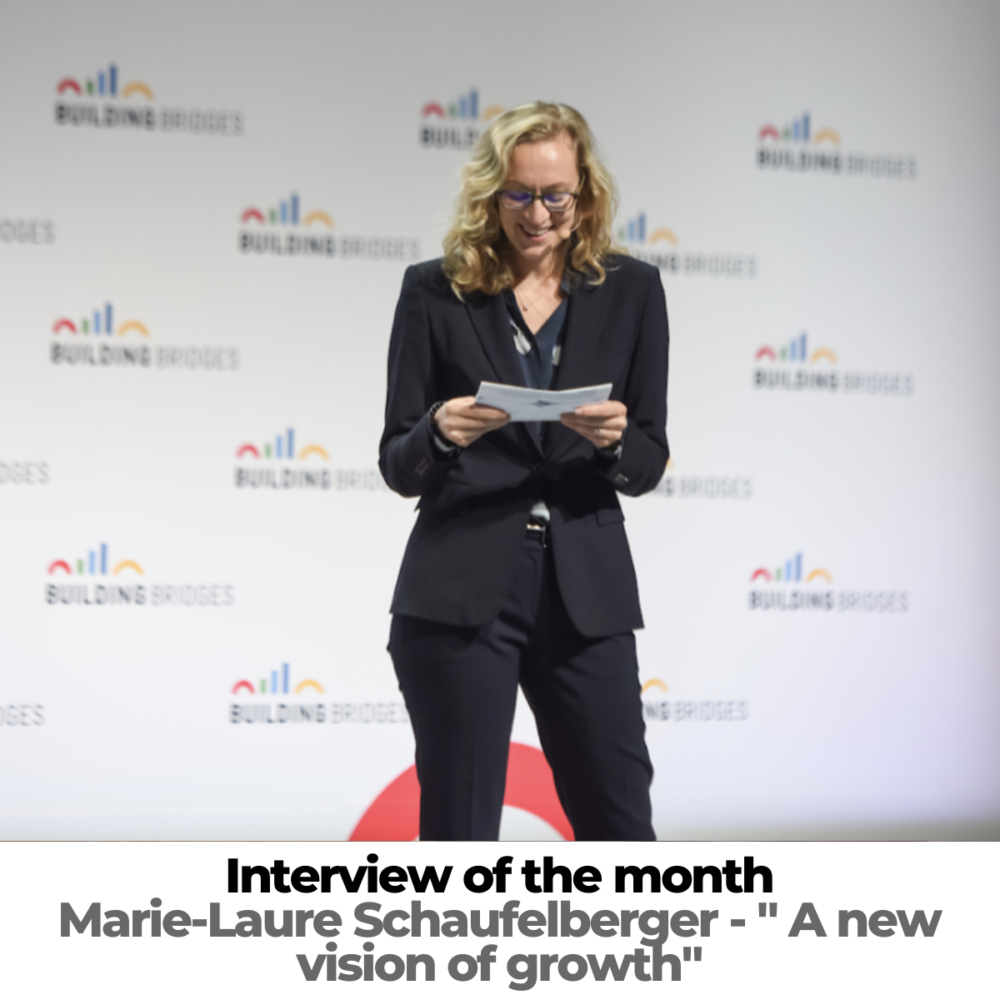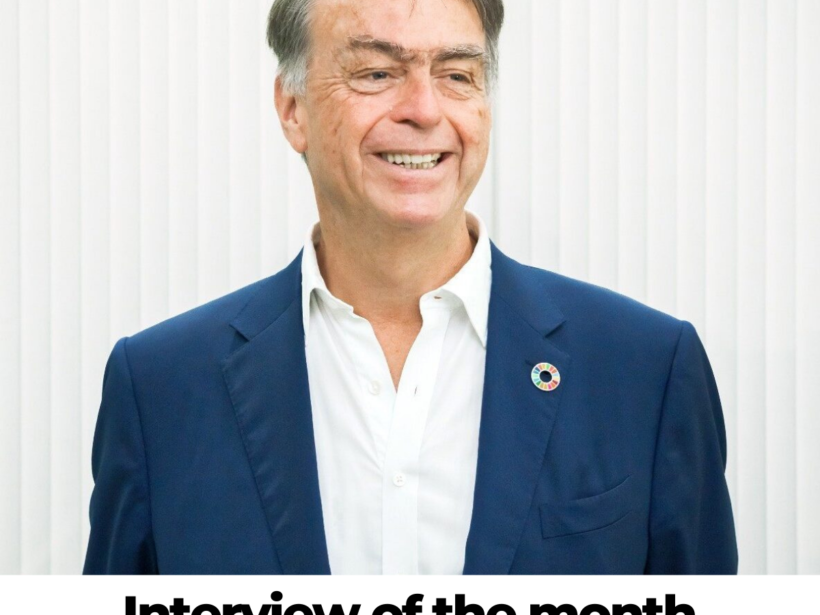
Interview of the Month : Marie-Laure Schaufelberger – “A new vision of growth”
This month, Anne Barrat from the newspaper Le Temps interviewed our president, Marie-Laure Schaufelberger, about her new vision of growth. This vision is focused on a transition towards a decarbonized and just economy, aiming to contribute to the well-being of all the inhabitants of the planet.
–
Sustainability should not be myopic; it should not solely revolve around climate change. This is the conviction of the Head of Sustainability at the Pictet Group, who aims to place mankind and its history at the core of today’s greatest challenge. All the rules governing human activities to reduce their destructive impact will only be effective if people see them as being in their own interests. For the President of Sustainable Finance Geneva, all stakeholders, including the financial sector, must reconsider the place of humans in their mobilization to keep within planetary boundaries.
Why is the concept of “planetary boundaries” important to you?
In recent years, the vast majority of discussions have revolved around climate change. The financial community and investors have taken up the subject, which is significant progress, however, there is still short-sightedness concerning the environmental dimension without considering the social dimension. Climate is one condition for living well on this planet, but it is not the only one. There are also planetary boundaries directly linked to human activity. If our activities go beyond these limits, by abusing water and soil and threatening biodiversity, we are ultimately endangering ourselves.The survival of our human societies, our economies and our social constructs depends on it. Natural systems are under pressure. So much so that these ecosystem services, which were previously “given” by the planet for free (air filtration, natural water treatment, etc.), will become paid services. Humans have exerted such influence over the biosphere that they have become the central actor. This is what is called the Anthropocene.
Does this mean that there is too much polarization on climate change?
The climate issue is crucial, and I am pleased with the results of the June 18th vote, which is a step in the right direction. But it must not crowd out all other issues.
Is finance too focused on climate change to the detriment of everything else?
Like society as a whole, finance has long focused on the economy at the expense of environmental and societal issues. It was only when these issues became financially material that there was a real awareness of their importance. In other words that they increased risks. It was the power of risk that forced the financial world to address the issues of climate change, water, etc. a good decade ago. They identified new risk factors that threatened the long-term maximization of their investments’ returns. Today, over 80% of European managers integrate ESG dimensions. It is less the case in the United States, but Asia is becoming increasingly interested. The focus is now on the impact of investment: how does the decision to commit funds to one company rather than another have a given social and environmental impact? We’ve moved on from risk to impact – it’s not the same thing.
What is the difference?
With the ESG approach, the goal is to measure risks. Finance has learned to do that and has deepened its knowledge of these factors day by day. Today, the industry is more interested in the real effects of investment opportunities. In the first phase of the rise of ESG criteria, appearance and marketing played a significant role in sustainability. ESG and sustainability were considered the same. However, this is not the case. Taking ESG criteria into account, i.e., managing environmental, social, and governance risks, is a necessary but insufficient condition to ensure the sustainability of our societies and the health of our planet. This confusion has also led to greenwashing: clients wanted their investments to have a tangible impact, so they were sold an ESG product. It is essential to be clear about the difference. An ESG fund does not necessarily have a specific impact. Not distinguishing between the two leads to mismatch in expectation and reality. Regulatory progress is gradually providing a necessary framework for “sustainable finance” to protect investors, especially in Europe, which is more advanced in this area, and the rest of the world.
Even in the United States?
There is a real polarization of science across the Atlantic. It is an issue that, in the run-up to elections, is used as an electoral tool. Large institutional investors, both on the East Coast and in California, are very concerned about the impact of their commitments on reducing climate risks and seek financial partners who manage opportunities in the ecological transition transparently. They take water problems, atmospheric heat, deforestation, etc., very seriously – issues that directly affect them. A striking example: when fires devastated hectares of forest in Canada a few weeks ago, American television only showed images of New York enveloped in an orange veil of fine particles from the smoke of these fires. These are long-term investors, and they are well aware of the major challenges already posed by a global temperature 1.2°C higher than pre-industrial levels and want to avoid at all costs the scenario of more than 2.4 °C that is unfolding before their eyes. Most of them, anyway.
Not all investors?
The pension funds in Texas, a state that produces 42% of American oil, are much more reluctant to give up brown investments. Their attitude, which is easily understandable, reflects a phenomenon that will become much more significant over the next five years: that of a just transition.
What does a just transition mean?
It means that populations can continue to live well and develop while reducing their destructive impact on nature. Therefore, they must find replacement solutions. It is revealing that in countries or regions where inhabitants highly depend on one or more raw materials, they are reluctant to giving up their livelihood. They are focused on the end of the month; the end of the world seems far away to them. It’s perfectly logical. It’s not out of malice; people do not destroy nature, which underpins more than 50% of our economies, for pleasure. They do it to feed their families. Therefore, they must be provided with products, sources of energy, etc., that allow them to live through this transition. Humans must be at the center of this just transition. We must add an H to the ESG criteria: the H of humans and history.
Does this just transition mean a decline?
Behind the issue of degrowth, there is actually the question: is it possible to decouple well-being maintenance or increase and the destruction of the planet? The answer is not the same in both hemispheres. In the North, the challenge is to maintain a pleasant standard of living, ensuring the safety and future of one’s children. Only an evolution of our economic and financial models can allow us to combine these objectives, based on a socially oriented market economy centered on humans and well-being, rather than on growth that does not consider the destruction of nature. This is one of conclusions, which I share, of the Beyond Growth 2023 conference organized by European parliamentarians last May. We need to put in place policies that ensure sustainable prosperity in Europe by systematically integrating economic, social and environmental sustainability. This requires a new vision of growth, perhaps less growth, but certainly different.
And in the South?
In the South, on the other hand, well-being is more often a goal than an achievement. It would be foolish to restrict the race for development in countries that lack hospital and road infrastructure, amongst other things. They need to be able to benefit from the capital that the West has managed to accumulate through its industrial development based on fossil fuels. They must be given the means to develop in a green way and face up to the consequences of climate change, which they are already experiencing.
Are investors willing to redistribute their capital to finance virtuous growth in the South?
Both public and private actors have an interest in doing so. The Southern regions currently house a significant portion of the remaining natural heritage on the planet. Indonesia, Brazil, and the Democratic Republic of the Congo represent more than 50% of the world’s forests. Mechanisms must be found to preserve and regenerate them. If we fail to reduce the imbalance between the North and the South, we will face an unmanageable immigration problem. We have a strong interest in mobilizing capital to promote sustainable, economic, and social development in entire regions. This transition is also an opportunity to innovate while respecting the planetary boundaries we all depend on, thus increasing well-being. On the other hand, a new generation is emerging, altering its food habits, consumption patterns, and focusing on digital experiences. They are willing to exchange goods for more well-being, and for more social justice. This will represent a true material decline. This generation supports a more efficient economy, reallocating capital where it is needed and not where it currently goes. And these are the customers of tomorrow.


